Families of Mustard Hyrn, Cess, Martham
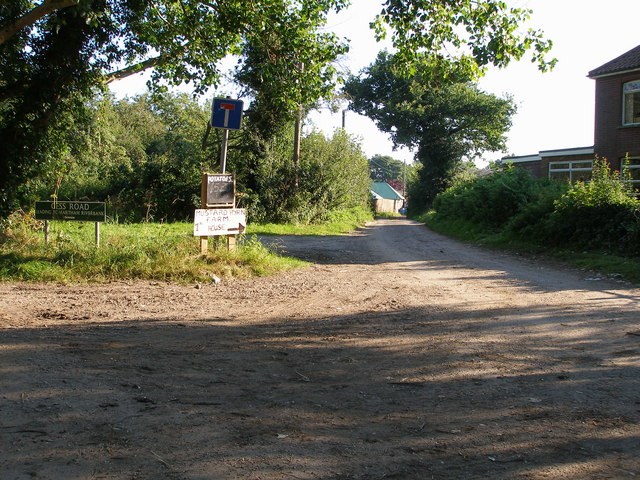
Many moons ago Mustard Hyrn was probably seperate from both Cess and Martham but is now a tiny hamlet within a hamlet. In this case Mustard Hyrn within Cess within Martham. It is situated to the north end of Cess, as a dead end, on the edge of the marshes and the River Thurne. The origin of the name Mustard is unknown as it supersedes that of mustard growing. Hyrn derives from bend or horn in old English. Generation after generation have lived there in a cluster of five to eight households since at least the 17th century and possibly much earlier. Here in the depths of remote Broadland, twixt fertile plough soil and never ending reedbeds, people have led a remote life on the edge of the village community and the edge of survival, for this is no rural idyll.

The rough area of Mustard Hyrn is outlined in red.
Local footpaths are dotted dark blue.
The River Thurne is shown in light blue.
Cess Road is shown in dark green.
River Lane (Private Road to the Boatyard) is shown in light green.
Source: Part of the 1812 Commissioners maps and records of the Dean & Chapter of Norwich.
Held in the Norwich Record Office Ref: CHC 11910 and BR 276/1/172.
The above map shows that Mustard Hyrn was served by two footpaths (dotted in dark blue) that still exist to this day as definitive Footpaths Nos5 & 6. Early residents would have used these to walk across the fields, and through Thunder Hill, to get to St Mary the Virgin Church at least once and sometimes twice on Sundays.
Most of those living at Mustard Hyrn laboured on the land. Some owned small plots of between six and ten acres, but it would not have yielded enough alone for them to survive. Fish and eels would have supplemented their diet from the nearby River Thurne.
Cottages were thatched with no running water or electricity and light was from candles. All the cottages at Mustard Hyrn had wells and three still exist. Toilets or earth closets were down the yard. Mains piped water did not arrive until the 1950’s.
Inventories(1) recorded between 1758 and 1772 for people living at Martham in general build a picture of one or two roomed cottages perhaps with a tiny scullery to the rear. The main, and often only room, would include a bed unless there was an attic room, which was often called a chamber. Beds normally had a coverlid (bedspread) and a sheet and blanket and were often curtained for privacy.
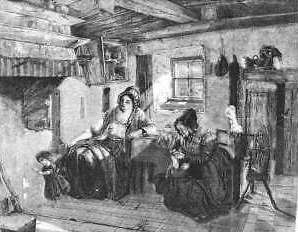
The fireplace was the focal point for heating and cooking. Some had a range but many only had an iron grate. Still more basic would be flat down-hearth fireplaces which could burn flaggs, the inferior top from peat diggings. In winter coal was carted from Great Yarmouth or at times brought by the river. It was common to have tongs and bellows amongst the grate irons as well as a spit. An iron cooking pot would hang from a hake (hook) over the fireplace. Fires would stay in continuously just being damped down at night.
Even the poorest of homes had wooden chairs, a table and a washing tub. Other utensils may include a porridge pot, brass or copper kettle, flat irons, toasting irons, wooden or earthenware dishes, numerous glass and stone bottles, a pail, cups and mugs. There are some instances of a bobbin used for winding spun yarn. Beer making equipment was not unusual as was the making of butter and bread.
Some inventories of those that had a trade like a carpenter or farmer included their tools which were often worth more than their household goods. Spades are listed for cutting peat and scythes for cutting hay for livestock that would be walked daily to the Common at Cess for grazing. Smallholders grew crops and would have kept chickens and rabbits whilst those with a bit more land would have bought lean cattle from the local market and fattened them up on the common or lush marshes. They would thrive there and once fat would be taken back to market throughout the winter months often for onward sale to the London markets.
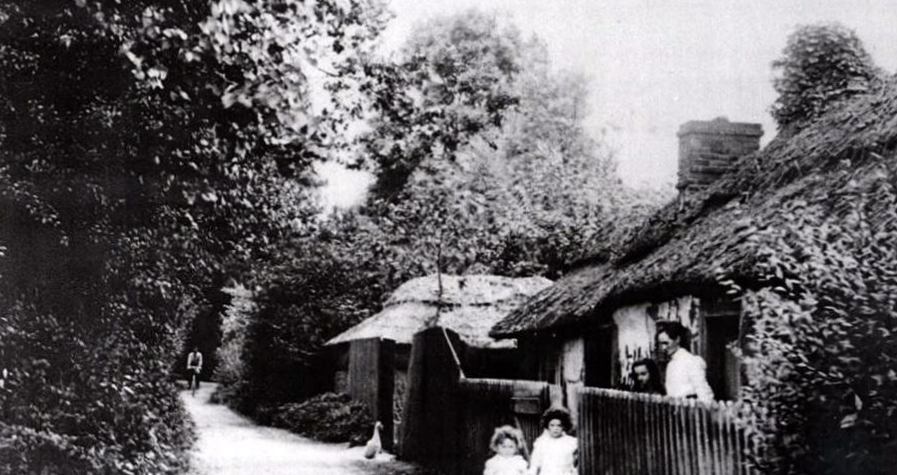
1812 Martham Inclosure Award
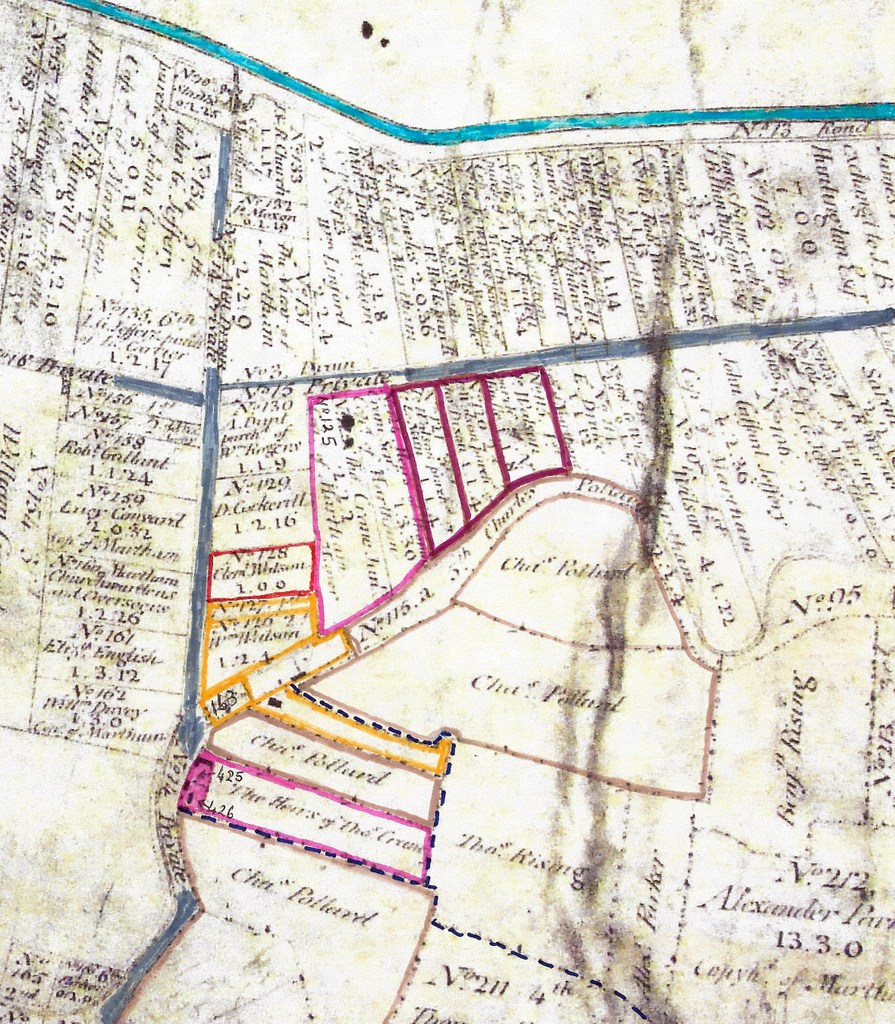
Part of the 1812 Martham Inclosure Award Map held by the
Norfolk Records Office.
The River Thurne is shown in blue.
Roads and tracks are shown in grey.
For other coloured plots see below.
The earliest formal record we have that lists land occupation and ownership in Martham is the 1812 Inclosure Award. The portion of the Inclosure map that includes the Mustard Hyrn area is shown above. This shows that the area had been farmed for many, many years and that the multitude of small fields, shown in strips known as ‘furlongs’, had grown as each had been split following inheritance over many years of family ownership.
Major landowners in the village tended to own land on the upper more fertile areas but almost always also owned marshes down by the river for cattle to graze in summer. The 1812 map shows that one of these was Charles Pollard (1764-1841) who owned the plots outlined in light brown. In all he owned just over 112 acres of land in the village making him one of the biggest village landowners of the day.
Thomas Crane Jnr. (1757-1833) and his father Thomas Crane Snr. (1726-1812) owned the plots outlined in pink. Thomas Crane Snr. died in January 1812 so the land he held was listed as “Heirs of Thomas Crane Snr”. He lived at Cranes Green Cottage adjacent to the Village Green but with his son he also owned some marshes.
Land owned by the long-established Watsons at Mustard Hyrn had been handed down from one generation to another and in 1812 was owned as follows:
Clement Watson (1745-1817) owned plot 128, shown outlined in red on the map, which was a marsh said to include a cottage occupied by his nephew John Watson. Clement was married to Susan Holland in 1767 and he died in 1817. Clement was the brother of William (1742-1818) and both of them had inherited land at Mustard Hyrn that belonged to their father Robert (1706-1787) – see below.
William Watson (1742-1818) owned plots 126, 127, 163 and some that were not numbered on the map. It included a cottage and barn at plot 163 plus the marshes at plots 126 & 127 all shown in yellow on the map. The land in question was occupied by his son William Jnr. (1773-1847). William was the brother of Clement (1745-1817) and both of them had inherited land at Mustard Hyrn that belonged to their father Robert (1706-1787) – see below.
John Watson (1778-1858) owned marshes at plots 115, 120 & 121 shown in purple on the map. John was the son of William Watson (1742-1818) – See more details about him below.
The Watsons were one of the oldest established families in Martham. Members of their family can be found in every census from 1841 to 1921 plus the 1939 Register and some of their descendants still live in the village today. In the 17th & 18th century the core of the family lived at Mustard Hyrn and luckily for historians seven of them across five generations made Wills. The following family tree shows the seven men, outlined in orange, that made those Wills and their descendants.
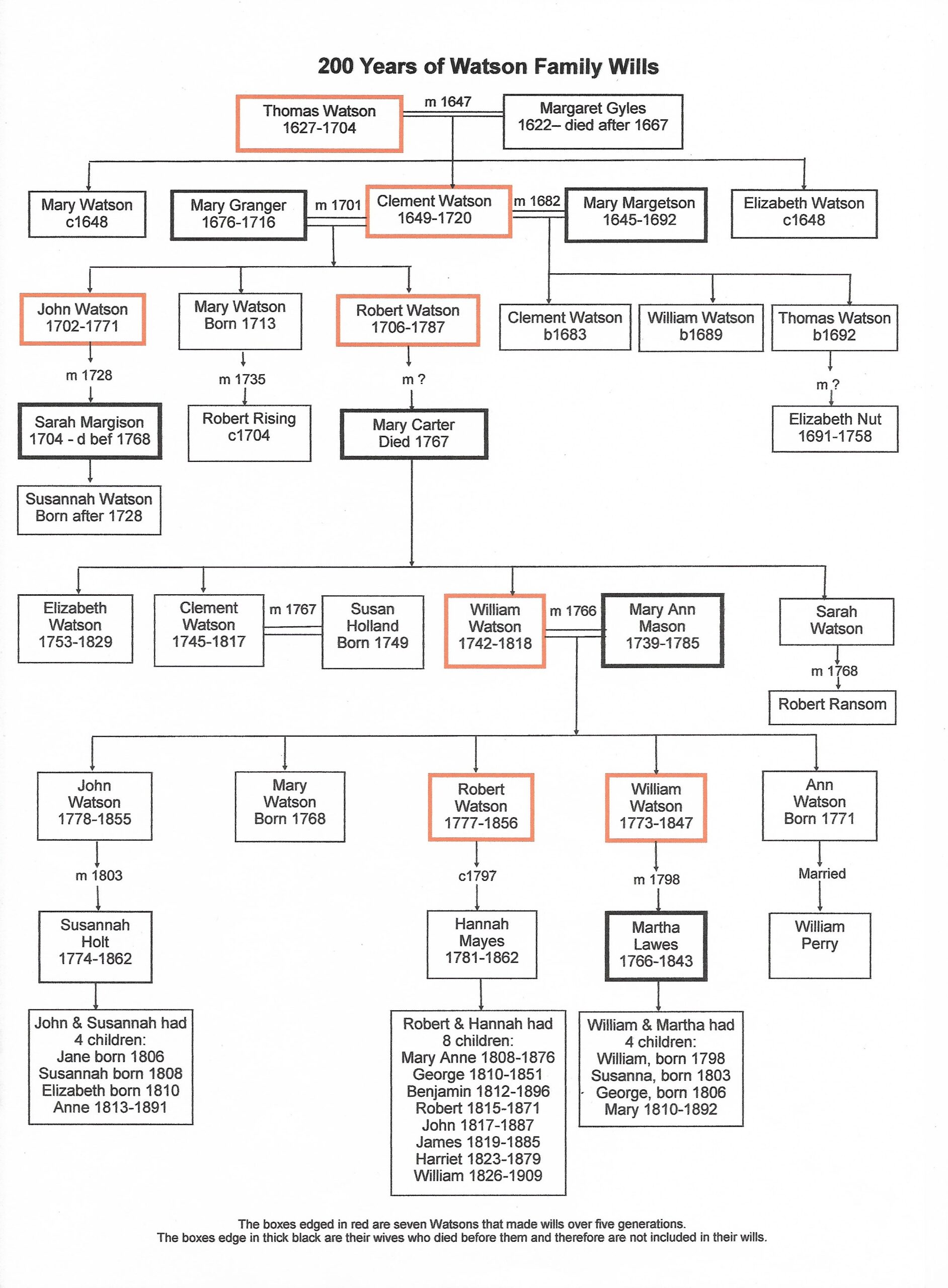
Thomas Watson 1627-1705
Thomas was born in 1627 in Ludham. His parents were Clement Watson & Anne, nee Edwards. He married Margaret Gyles at Honing on 30th September 1647 and they moved to Mustard Hyrn after their three children were born. They were:- Mary in 1648, Clement in 1649 and Elizabeth whose date of birth is unknown but her name appears in her father’s Will dated 6th September 1667. His Will says he owned land in both Martham and Potter Heigham and it gives strong indications of how influential the Church was on the everyday life of people and the religious views of the day. Much of the opening section of his Will is taken up with his belief in God and his hope for eternal life after death. He left the bulk of his estate to his wife for the rest of her life. After her death his houses and land were inherited by his son Clement. Thomas also made two legacies of £20 each to his daughters Mary and Elizabeth and another of £5 to Mary when she became 21 years of age (she was 19 at the time of his Will). He made his Will 37 years before his death and does not seem to have amended it. If you want to see a transcript of his Will click HERE which will open a pdf in a new tab. The original document is difficult to read and words with a question mark are indecipherable.
It is an amazing thought that Thomas was probably aware of the great fire of London that happened almost exactly a year before he made his Will.
Clement Watson (1649-1720)
Clement was the son of the above Thomas Watson (1627-1704) and was born in 1649 at Ludham. He was a beneficiary of his father’s Will of 1667. When he was 33, he married Mary Margetson on 12th June 1682 at Potter Heigham, Norfolk. Mary died in 1692 and Clement married again on 16th June 1701 to another lady called Mary, who was Mary Granger; their marriage took place at St Mary the Virgin, Martham. Clement had three children with each of his wives.
Clement made his Will on 13th July 1714 describing himself as a yeoman. In that year he would have been aware of the Coronation of George I heralding the beginning of the Georgian era. Clement died in 1720 and is buried at St Mary the Virgin Church but the exact plot position is unknown. His Will suggests he was a deeply religious man. He owned property and land in Martham and Potter Heigham which he left firstly to his 2nd wife for the natural term of her life and upon her death to John & Robert his two sons by her. As it happened his second wife died in 1716 so presumably John & Robert inherited in 1720 even though they were still not 21. Clement also left monetary legacies to his three children by his first wife of £5 each and £15 to his daughter Mary but these were to be paid over a period of six years at £5 per year by John & Robert after their mother’s death. This arrangement must have been because Clement had no ready cash and the income from the land he owned was small. He listed stock, crops, chattels and household goods but nothing in detail. If you want to see a transcript of his Will click HERE which will open a pdf in a new tab. The original document is difficult to read and words with a question mark are indecipherable.
John Watson (1702-1771)
John was born on 20th February 1702 in Martham. (His birth and baptism fall in a double-digit year and what they then called 1702 would today be known as 1703). He grew up living at Mustard Hyrn with his parents Clement & Mary, nee Granger, and inherited houses and land in his father’s Will (after his mother’s death) to be shared equally with his brother Robert. He married Sarah Margison on 9th September 1728 at St Nicholas Church, Buckenham, Norfolk. Sarah must have died before 1768 as she does not feature in his Will dated 25th October 1768. There is no indication that John farmed the land he had inherited but later he was recorded as being the Ecclesiastical Clerk at St Mary’s. He may have simply let the land and houses he had inherited. Referring to two acres of land and houses at Mustard Hyrn he left them to his granddaughter Elizabeth Brown. Also referring to ‘both’ houses and land left to him by his father he left them, along with goods, chattels, bonds and ready cash to his daughter Susannah Watson. Upon Susannah’s death he expressed the wish that the land was to revert to his nephew William, the son of his brother Robert. He also seems to have owned a half share (under his father’s Will) in a house on The Green in Martham which he left to his sister Mary Rising, nee Watson. His Will seems to indicate that he was quite controlling in nature and is attempting to set high moral standard. He stipulates that his heirs must only be lawfully begotten and that they will forfeit bequests if they subsequently take out loans or mortgages against property or land. He made bequests subject to who will inherit after them, thus removing any choice they may have when they die. Looking at the wider world I wonder if John knew that in the year he made his Will Captain James Cook departed from Plymouth on his first voyage of exploration of the Pacific on board HMS Endeavour. If you want to see a transcript of his Will click HERE which will open a pdf in a new tab. The original document is difficult to read and words with a question mark are indecipherable.
Robert Watson (1706-1787)
Robert was born on 14th July 1706 at Martham. He grew up living at Mustard Hyrn with his parents Clement and Mary, nee Granger. He became a cordwainer and married Mary Carter with whom he had four children:- William, born in 1742, Clement born in 1745, Elizabeth, born in 1753 and Sarah (date unknown). Robert made his Will on 16th March 1769 and on the face of it makes bequests that must have been difficult to manage. He left his house to be shared between his two sons William and Clement by giving the west end of his house to William and a meadow to its north and a back yard whilst Clement got the east end of the house with an adjoining meadow and a back yard plus a long yard running along the lane. Robert also said that Clement should pay his married sister Sarah Ransom £10 within a year of his death. If you want to see a transcript of his Will click HERE which will open as a Word document in a new tab. The original document is difficult to read and words with a question mark are indecipherable.
So, one house with presumably one front door was split between William and his brother Clement. The other explanation is that it was actually a semi-detached pair that Robert referred to as ‘his house’.
Robert also had a daughter called Elizabeth who had married John Manship two years before Robert made his Will in 1767 but she is not a beneficiary in it. Robert died at Martham in 1787, aged 81, and was buried on 14th June 1787 at St Mary the Virgin graveyard but the exact plot is unknown.
In 1807/1808 W & C WATSON paid six shillings per year in Land Tax for the property they owned. These were almost certainly William & Clement. People were liable for this tax as owners and occupants of property under two Acts of George III (1760-1820). The registers list owners and occupiers of land that were subject to the tax but do not provide details of the properties.
William Watson (1742-1818)
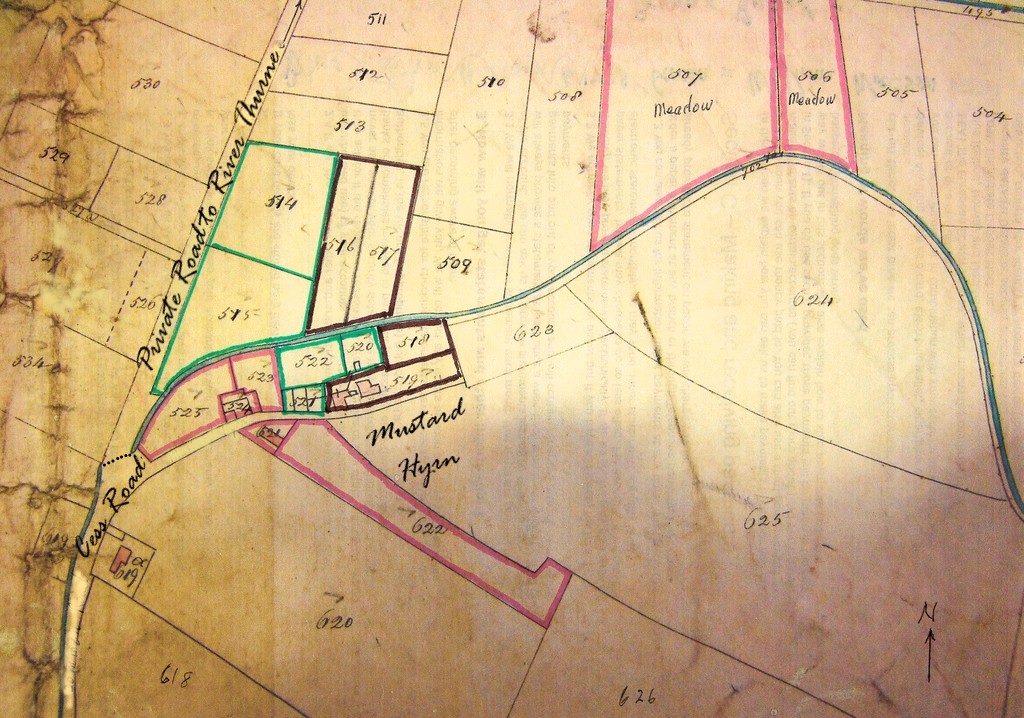
The map shows the land owned by William Watson after the inheritance from his father Robert. The sharing of land and premises detailed in his father’s Will must have been resolved because this map shows how William split up his land and left it to his three sons; William (1773-1847) the land outlined in green; Robert (1777-1856) the land outlined in brown and John (1778-1858) the land outlined in pink.
William was born in about 1742 and grew up with his parents Robert & Mary, nee Carter at Mustard Hyrn and like his father became a cordwainer but was also a farmer. When he was 24, he married Mary Ann Mason, the daughter of John & Mary Mason, on 11th February 1766 at Repps cum Bastwick where Mary came from whilst William was recorded as being ‘of Martham’.
William & Mary had the following children at Mustard Hyrn:
- Mary WATSON was born in 1768 and was baptised at St Mary’s on 7th May that year.
- Ann WATSON was born in 1771 and was baptised at St Mary’s on 7th July that year.
- William WATSON was born in 1773. He married Martha LAWES on 5th November 1798 at Caister-on-Sea. He died in October 1847 at Martham.
- Robert WATSON was born in 1777 and was baptised at St Mary’s on 8th July that year. He married Hannah MAYES before 1797 (based on birth of their first son). Robert died on 4th June 1856 at Martham.
- John WATSON was born in 1778 and was baptised at St Mary’s on 15th October that year. He married Susannah HOLT on 8th December 1803 at St Mary’s He died on 28th November 1858 at Martham.
William Watson made his Will on 21st March 1805. We have seen above that he had inherited half a house from his father whilst his brother Clement got the other half. His Will makes it clear that a new house had been built which he now left to his son John (1778-1858). This sat in eight perches of land and in addition he received a stack yard that had a shed on it. A stack yard was a farm yard used to store hay to fatten cows in winter.
William also left his son William (1773-1847) all his other houses, lands, tenements, and buildings in Martham without describing exactly where they were.
John and William inherited these on condition that they paid off the outstanding mortgage of £100 plus any interest.
William’s other son Robert (1777-1856), daughters Mary (born 1768) and Ann (born 1771) were each given £15.
If you want to see a transcript of his Will click HERE which will open a pdf in a new tab. The original document is difficult to read and words with a question mark are indecipherable.
William died in June 1818 at Martham and was buried on 23rd June 1818 in the graveyard at St Mary the Virgin but the exact plot is unknown. As he died in 1818 he was around long enough to claim ownership of land under the 1812 Martham Inclosure Award the details of which you can see under “1812” above.
In 1805, the year William made his Will, the last great battle of the age of sail took place at Trafalgar. Norfolk hero Admiral Lord Nelson led the attack on board HMS ‘Victory’ but was famously killed at the height of the battle. I wonder if this news reached the hamlet of Mustard Hyrn?
William Watson (1773-1847)
William was the son of William Watson & Mary Ann, nee Mason. He was born at Martham in 1773 and married Martha Lawes at Caister-on-Sea on 5th November 1798. Martha died in 1843 and is buried in the graveyard at St Mary’s section F, plot A3. William made his Will on 13th October 1847 and died within a week of making it. Perhaps for this reason his Will is in a rather muddled order. He owned the land outlined in green on the above map. Unlike his ancestors his Will made no mention of spiritual matters. His bequests may be summarised as follows:
He left his meadow and marsh land to his son William on condition that William paid £40 to his sister Susannah. This was probably plots 514 & 515 shown in green on the above 1842 Tithe Award map.
He left the south-west end of his cottage at Mustard Hyrn with buildings to the south-west plus half of his dairy to his son George. This cottage was probably on plot 520. He also left George another cottage said to be in his own occupation over the road and opposite his other cottage subject to George paying £30 to his sister Mary.
He left the kitchen in the north-west end half of his cottage, its yard, workhouse, other half of his dairy and land to the northeast of his cottage to his daughter Mary.
He left all his household furniture and implements to his two daughters Susanna and Mary to share equally.
He left all his live and dead stock, crops of corn, grain and hay to be shared by both his sons and both his daughters.
Not surprisingly he may have been expecting some disagreements between his children over the detail of the legacies because he appointed his brother John to be the final arbitrator between them in the event of any dispute. Further, he even gave his daughters powers of recovery by distress against their brothers if the money legacies of £40 and £30 were not paid.
If you want to see a transcript of his Will click HERE which will open a pdf in a new tab. The original document is difficult to read and words with a question mark are indecipherable.
Robert Watson (1777-1856)
Robert was the son of William Watson and Mary, nee Mason. He was born at Martham in 1777 and later married Hannah Mayes from Sutton near Stalham.
The map on the right is part of the 1842 Martham Tithe Award map held by the Norfolk Records Office. The Award lists Robert as the owner of plots 516, 517, 518 & 519 that were at Mustard Hyrn, Cess plus plot 20 (shown outlined in red on the map to the right) that was arable land at Staithe Road just opposite the north end of School Road which he had purchased from the widow Sarah Deary, nee Whitaker. Plot 20 was known as Burnt Yard and was three acres and was part of a bigger plot of 4 acres and 2 rods. It was split when sold and plot 20a was sold to James Rust (1783-1859).
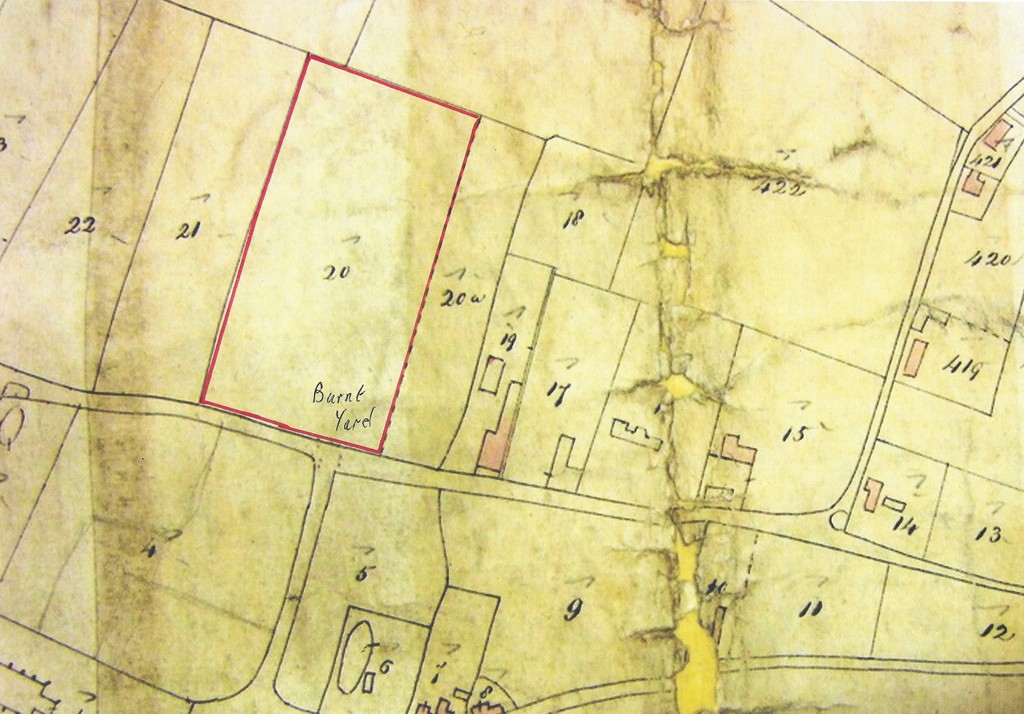
(Above right is part of the 1842 Martham Tithe Award Map held by the Norfolk Records Office).
He made his Will on 8th April 1848 and died at Martham on 4th June 1856. At that time he owned the land outlined in brown on the above map. Interestingly there is a note written before the actual Will that says, “Testator lived and died at Martham in the County of Norfolk”. The opening lines of his Will then contradicts that statement.
The actual situation is confirmed by the 1841 & 1851 census returns that tell us that Robert lived with his wife and children at Watson’s Marsh Mill at Heigham Holmes on the north side of the River Thurne. Although the Mill is on the north bank at Heigham Holmes and geographically is in Potter Heigham there is no land route to Potter Heigham. The nearest practical village was Martham. They needed a boat to reach either of them. In all practical ways the family would have taken a rowing boat across the river to Martham ferry and then gone up Ferrygate Lane to reach Martham village for shopping or worship needs as that was closer than Potter Heigham.
Robert’s Will starts as follows:-
“The last Will and testament of me Robert Watson of Potter Heigham
in the County of Norfolk, farmer. I appoint Hannah, my wife, and
sons George Watson and Robert Watson Executrix and Executors of this my
will and I direct that all my just debts and my funeral and testamentary(1)
expenses shall be paid and satisfied as soon as conveniently can be after
my death.”
1 = Executors to a Will may receive letters testamentary, authorising them to distribute the assets.
The following is a summary of the rest of his Will:- He left all his personal estate to his wife for the rest of her life she being responsible for paying interest on a mortgage he had.
He left a house, outhouses, pasture, marshland, garden, yard and appurtenances amounting to one and a half acres at Mustard Hyrn to his son James Watson. These had previously been owned by his father and in 1848 were occupied by John Conyard (1825-1902) who was the husband of Mary Watson (1810-1892) Robert’s niece.
He also left his son James (after his mother’s death) his six best chairs and a mahogany dining table plus his own, James’, bed. (James never married. His mother, Hannah, died in 1862).
In addition, Robert left a double cottage and barn plus outbuildings, yard and about three acres of arable land known as Burnt Yard to his sons George and Robert Watson. As mentioned above Robert had purchased this from the widow Sarah Deary (nee Whitaker) and at the time of writing his Will it was occupied by his son John Watson and John Holt. (John Holt was the nephew of sisters Judith & Susannah Holt who had both married into the Watson family). The legacy was subject to the property being sold after the death of Robert’s wife Hannah and the proceeds being split equally between their other children who were:
Daughter, Mary Ann Haylett, nee Watson (1808-1876).
Son, George Watson (1810-1851).
Son, Benjamin Watson (1812-1896).
Son, Robert Watson (1815-1871).
Son, John Watson (1817-1887).
Daughter, Harriet Piggin, nee Watson (1823-1879).
Son, William Watson (1826-1909).
And, if any of them died before him their share was to be divided equally between their children. His Will was dated 1848 so his son George did die before his father and that share would have gone to George’s daughter Harriet. The properties were duly auctioned in June 1863.
If you want to see a transcript of his Will click HERE which will open a pdf in a new tab. The original document is difficult to read and words with a question mark are indecipherable.
John Watson (1778-1858)
John was the son of William Watson and Mary, nee Mason. He was baptised at St Mary the Virgin Church on 15th October 1778 and married Susannah, nee Holt (1774-1862) at St Mary’s on 8th December 1803. At the time of the 1812 Inclosure Award John claimed ownership of land amounting to a total of 6 acres, 1 rod and 1 perch made up of a cottage, outbuildings, yard, gardens & meadow. He inherited land and a pightle from his father in 1818 and that left him owning the land outlined in pink on the above map. He did not make a Will so it is difficult to trace who inherited his land and premises following his death. John & Susannah had four daughters who were all middle aged and had made their own lives by the time their parents died. John’s wife Susanna died after him so it is possible she inherited all his property. There are no records to tell us which descendants subsequently came to own the land but we do know that even today the same land is cultivated as a smallholding by a member of the Turner family that is related to the Watsons on the maternal side of their family tree.
1841 Census
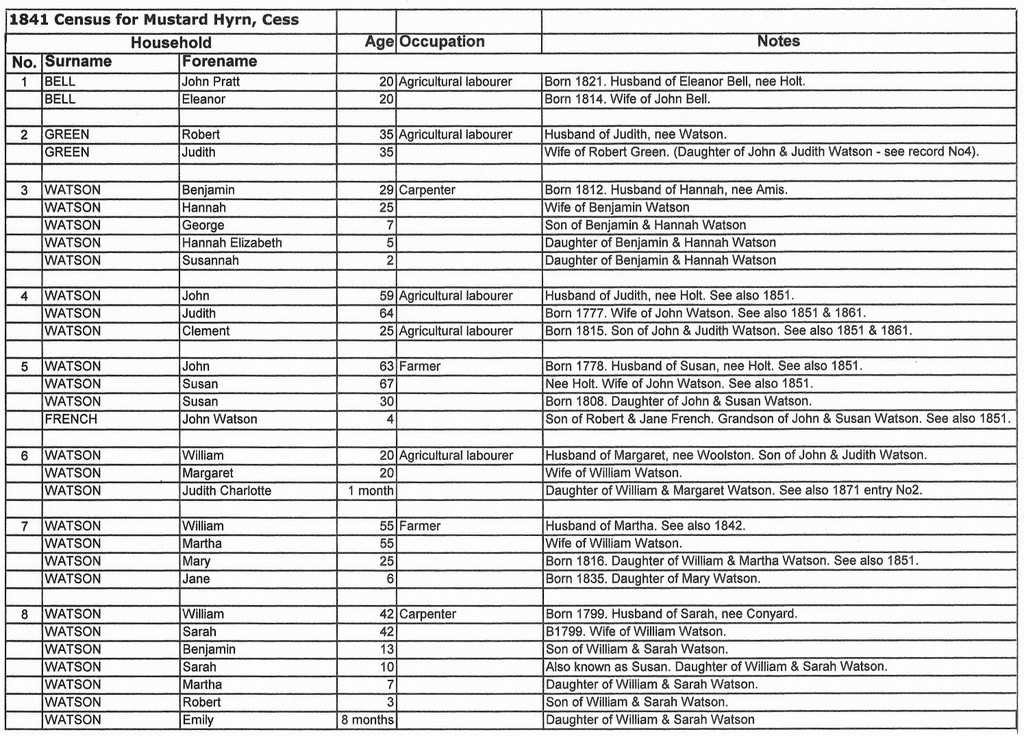
The 1841 census gives us another one-off view of who was living in the village at that time. At Mustard Hyrn there were eight different households. None of the homes were numbered or had names. The family groups are listed above. The Watsons were the main occupiers and consisted of six new generations since 1812. Two were carpenters rather than the majority of occupiers who worked on farms. John & Judith Watson (No4) were the parents of William Watson (No6). Judith, the wife of Robert Green on the list as No2 was also the daughter of John & Judith Watson (No4). Remarkably none of the other Watsons were closely related to each other. The other residents at the hamlet were John & Eleanor Bell (No1).
1842 Martham Tithe Award
Only a year after the 1841 census came the 1842 Martham Tithe Award. The Tithe Award was drawn because the Tithe Commutation Act of 1836 required that payments of tithes in the form of farm produce should be replaced by money payments. Tithe was a tax, which was paid to the local church. Tithe maps generally show the boundaries of woods, fields, roads, waterways and buildings. The portion of the map that relates to Mustard Hyrn is shown above with land highlighted in green, pink and brown owned by the three Watson brothers that have already been mentioned above but below are details of their land holdings in 1842.
William Watson (1773-1847) the husband of Martha, nee Lawes owned plot Nos. 514, 515, 520, 521 & 522 shown in green on the above map. Plots 514 & 515 were marshes, 520 was a garden, whilst 521 & 522 were both described as a cottage and garden. In all there were 4 acres, 2 rods and 7 perches. William left this land in his Will as detailed previously.
Robert Watson (1777-1856) owned the land outlined in brown on the map (plots 516, 517, 518 & 519). He was the husband of Hannah, nee Mayes. Robert lived in another part of Cess in 1841 but appears to have moved back to Mustard Hyrn by 1842 and lived at a cottage on plot 519. Robert left this land in his Will as detailed above.
John Watson (1778-1858) the husband of Susanna, nee Holt, was the owner of 6 acres, 1 rod & 1 perch of land made up of seven plots numbered 506, 507, 523, 524, 525, 621 & 622. The plots are shown in pink on the above map.
1851 Census
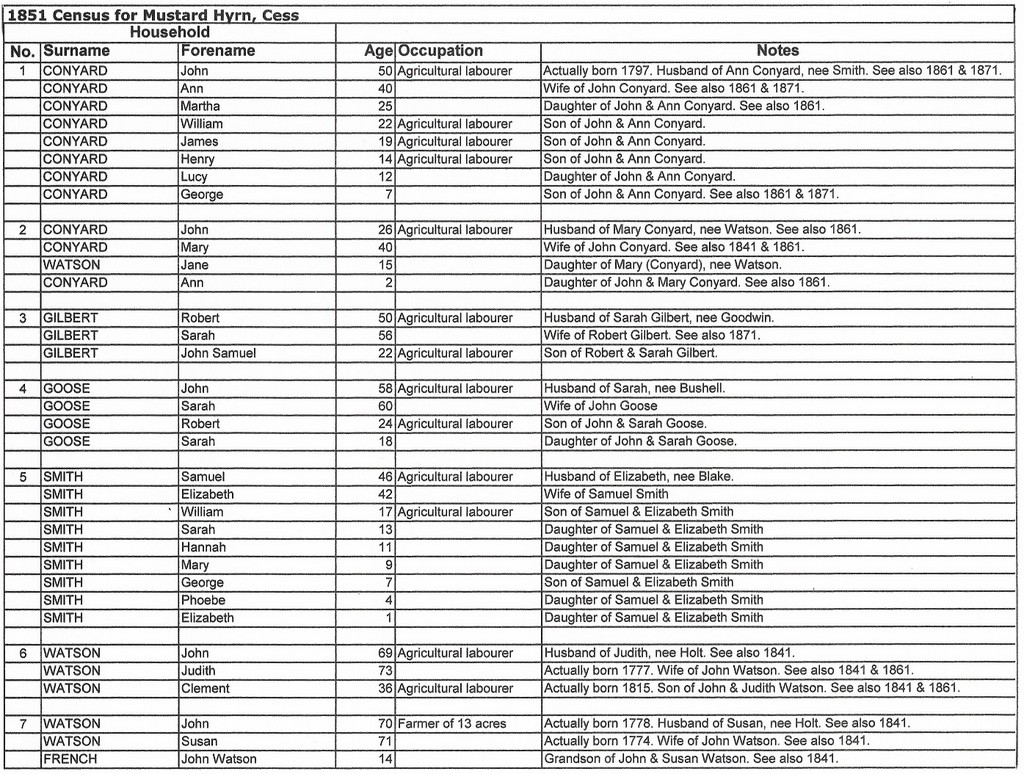
The 1851 census tells us that seven families lived there and again none of their homes were numbered or had names. The 1851 family groups are listed above. The presence of the Watsons had declined but John Watson and his wife Judith, nee Holt still lived there and are listed under entry No6. John Watson & Susan, nee Holt were also still there and are listed as No7. Judith & Susan were sisters; daughters of William & Sarah Holt who were originally from Horning.
Another lasting connection from ten years earlier was Mary Watson the daughter of William & Martha who had lived there with her parents in 1841 but married John Conyard in 1848 and remained at Mustard Hyrn. John was born in 1825 at Martham and his parents John & Ann Conyard, plus a number of his siblings, also lived in the close-knit community. Newer residents included the Gilbert, Goose and Smith families.
1861 Census

The 1861 census shows that seven families lived there and again none of the homes were numbered or had names. The Conyards that lived there ten years earlier were still there and so were Robert Watson (1808-1874) & his wife Hannah, nee Coleman, on the list as No7. The proximity of the River Thurne probably attracted new residents like the Harris family, see No3. Robert Harris was originally from Repps but lived with his wife Mary, nee Bessy, and was listed as being a waterman and probably worked on wherries. They had a son called John Benjamin Harris, born 1842, who probably worked with his father on the same wherry as it was common for sons to follow fathers in that work. New to the area were Robert Huggins and his wife Harriett, nee Raven, see No5.
1871 Census
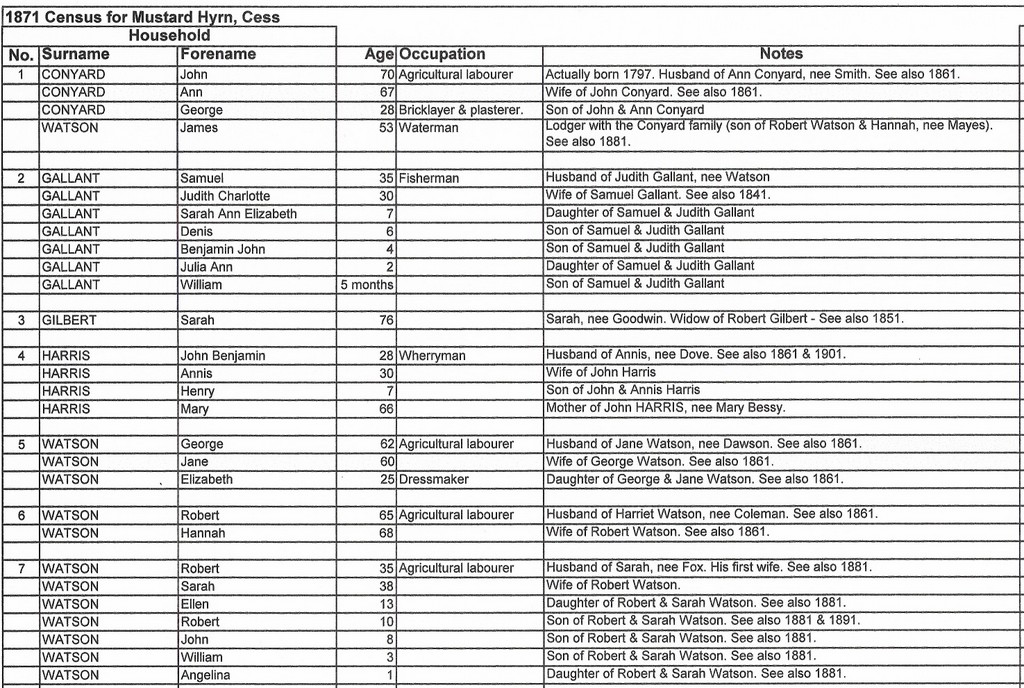
Just like the previous census there were seven families living at Mustard Hyrn in 1871 and none of the properties were numbered or had names. John & Ann Conyard had been there since at least 1851 and their son George, born 1843, was a bricklayer and plasterer.
John Harris had married Annis Dove only a few months earlier at St Mary’s and he was still a wherryman.
The Watson family groups were there in strength again: Judith Charlotte Watson had been born at Mustard Hyrn in 1841 to William & Margaret Watson and had gone on to marry Samuel Gallant in 1864 at St Mary’s. She and Samuel had five children living with them – see entry No2.
George Watson and his wife Jane, nee Dawson, No5 had been there since at least 1861 as had Robert Watson and his wife Hannah, nee Coleman – No6.
Newcomers were another Robert Watson, born about 1836, and his first wife Sarah, nee Fox.
1881 Census
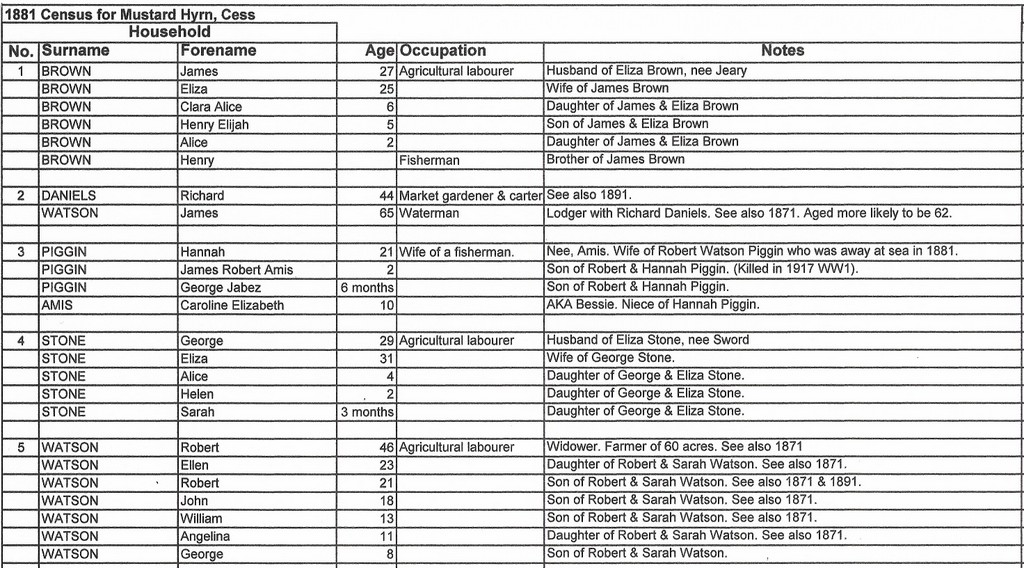
There were only five properties recorded as being occupied there at the time of the 1881 census and just as before none were numbered. In those days everyone knew everyone else and there was little reason to give a house a number.
Robert Watson from the 1871/7 entry had become a widower and lived there with six of his children – see entry No5.
Three new families had moved in named Brown, Piggin and Stone.
The entry No2 lists an interesting character named James Watson who was lodging with Richard Daniels and was previously listed as a lodger with the Conyard family under No1871/1. James was disabled having only one leg. He grew up with his parents at Watson’s Marsh Mill in a very remote place on Heigham Holmes on the north bank of the River Thurne. As the mill was on the north bank of the river it was geographically in Potter Heigham but the nearest practical village was Martham. Consequently, the best, and possibly the only way to reach either place was by boat.
Over many years James gained a reputation as a guide taking fishermen out on the river to the best fishing spots. On Monday 6th April 1885 he left the Waterman’s Arms PH, at Potter Heigham and had passed but a few yards to the east of the (then) railway bridge, when he was seen to fall overboard between his boat and the bank. Some nearby fishermen raised the alarm. Mr Applegate and Mr Laws, the landlord of the pub, ran to the rescue as due to his disability James was unable to help himself ashore. He was pulled onto the bank and brought round. Having been cared for he was taken to his home at Mustard Hyrn. Sadly, his condition became worse and Dr. Crisp, of Martham, was sent for but James gradually deteriorated and died in the early hours of the morning of Tuesday 7th. At the subsequent inquest Dr. Crisp said, “In his opinion James died from the effects of strong drink and shock to the system, caused by falling into the water.”
1891 Census
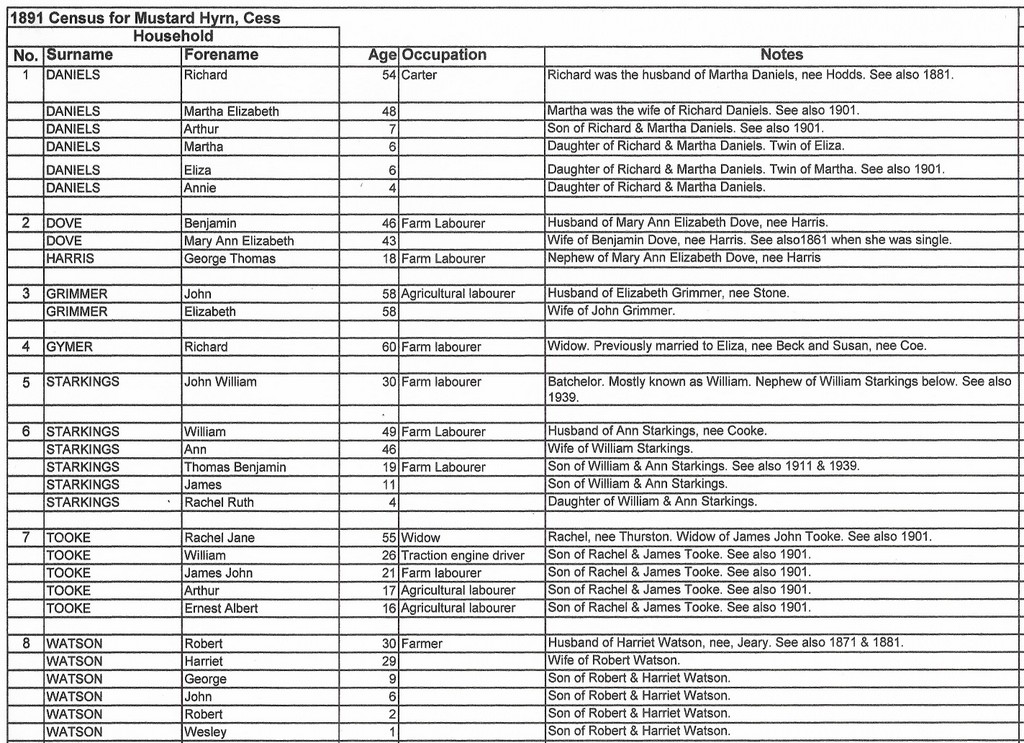
Similar to some previous years there were eight properties recorded as being occupied in the Mustard Hyrn cluster at the time of the 1891 census and just as before none were numbered. The big difference this time was that five of the seven families had moved in during the preceding ten years. Two from earlier years were: Richard Daniels, see No1, who had married Martha Elizabeth Hodds in 1882 and Robert Watson from 1871/7 as a 10-year-old and 1881/5 when he was still single, since then he had married Harriet Jeary.
The five new residents were Benjamin & Mary Dove plus a nephew called George Thomas Harris; John & Elizabeth Grimmer; Richard Gymer; William & Ann Starkings and Rachel & William Tooke.
1901 Census
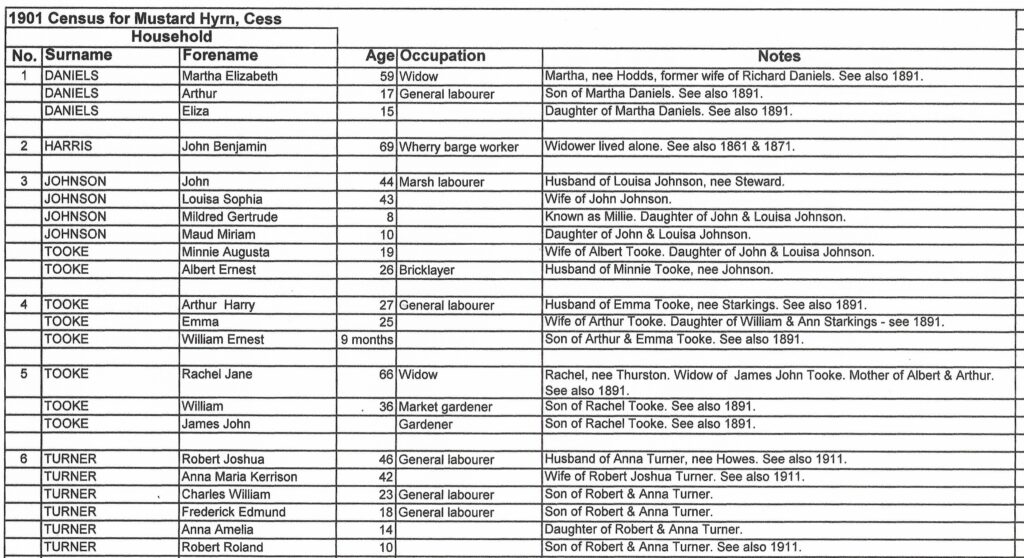
In 1901 there were six family groups living there, some of which were made up of multiple generations.
Martha Daniels had become a widow when her husband Richard died in 1900 in a tragic accident when he fell from his cart full of stones and was run over. Martha had a son and daughter living with her.
John Benjamin Harris had become a widower and lived alone having previously lived there in 1861 and 1871.
John & Louisa Johnson plus three of their daughters had moved in and one, Minnie, was married to Albert Tooke and they all lived in one house, see No3. Next door to them was Albert’s brother Arthur and his wife Emma, nee Starkings, see No4. And next door to them was Albert & Arthur’s mother, the widow, Rachel Tooke, see No5.
Robert Joshua Turner and his wife Anna, nee Howes had moved in and lived there with four of their children, see No6.
1911 Census
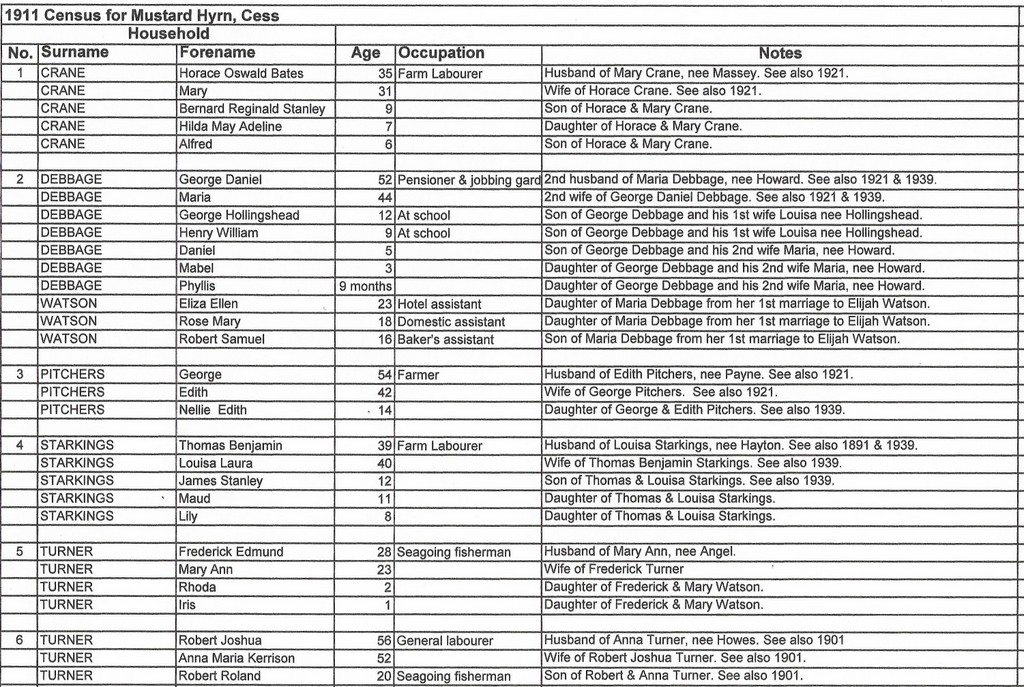
There were again six families listed in the 1911 census as living at Mustard Hyrn.
Horace & Mary Crane from Catfield had moved in with three children, see No1. It is believed they lived at No1 Hyrndale.
George & Maria Debbage had moved in with eight children. Five were their own and three were from Maria’s previous marriage, see No2. They lived ay No2 Hyrndale.
George Pitchers & his wife Edith, nee Payne were more new arrivals. George was originally from West Somerton and Edith from Great Ormesby, see No3.
Thomas Benjamin Starkings had lived there with his parents in 1891 and had now grown up and married Louisa Hayton. They were there with their three children and were destined to remain there long term as they were also recorded as living there in 1939, see No4.
Robert & Anna Turner were still there as they had been in 1901 and in addition their son Frederick had married Mary Ann Angel in 1906 and now lived next door to his parents, see Nos 5 & 6.
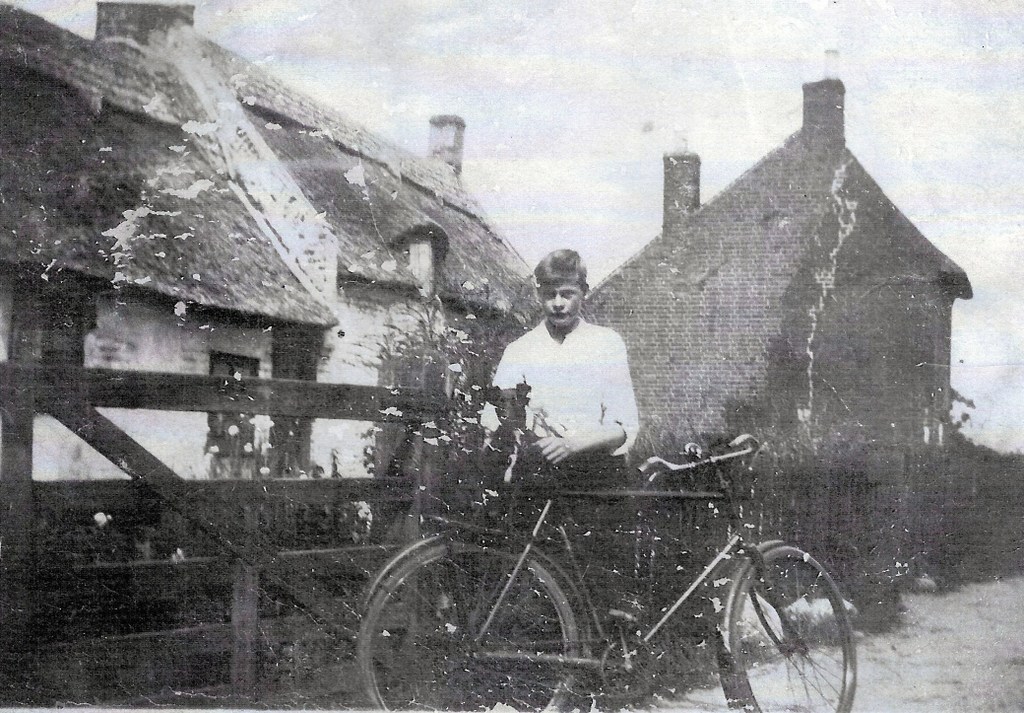
His parents were Robert & Rose Turner. Robert lived there with his parents in 1911 when he was single before he married Rose Watson in December 1913.
1921 Census
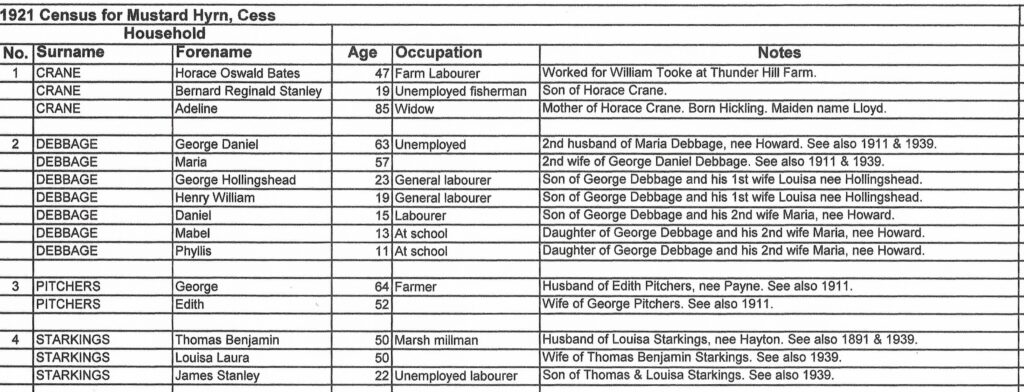
Sadly, none of the entries for this most recently available national census had addresses recorded as Mustard Hyrn, instead they were just recorded as Cess, Martham. This makes it almost impossible to use this source to identify all those who were living there at the time. However, some families who were there in 1911 and 1939 can obviously also be found in the 1921 records. They are shown in the list above. According to locals the Crane family lived at No1 Hyrndale whiles the Debbages were next door at No2.
1939 Register
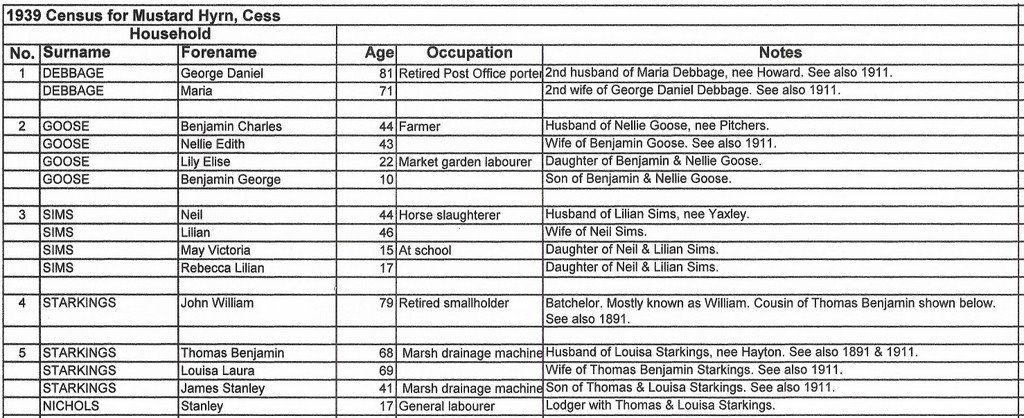
Eighteen years passed since the last census and not surprisingly the families had changed again leaving five households remaining.
George & Maria Debbage had remained there since at least 1911 but their children had since flown the nest, see No1.
Nellie Edith Pitchers had lived there with her parents in 1911 and was still there in 1921 and 1939 having married Benjamin Charles Goose in 1916. They were living at Mustard Hyrn in 1929 when their son Benjamin was baptised at St Mary the Virgin. They and their ancestors are one of the most well-known families to grace the area with other family members living at Rose Farm, Cess for many years.
Neil Sims and his wife Lilian, nee Yaxley, also lived at Mustard Hyrn. Originally from Suffolk, Neil became one of the characters of Martham known near and wide as a master horse slaughterer.
Post 1940
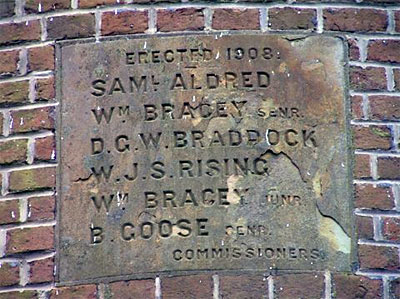
The Goose family has had a lasting and growing impact on the land at Mustard Hyrn and elsewhere at Cess. Several generations of the family named their first son Benjamin. We have seen above that Benjamin Charles Goose (1895-1962) had lived there with his wife Nellie in 1939. His father, of exactly the same name, but born in 1868 lived at Cess and was one of the Commissioners of Drainage recorded on a plaque to commemorate the buildings of Bracey’s drainage mill/pump that was built in 1908 not far from Mustard Hyrn. The purpose of the pump was to help drain the marshes to improve cultivation.
Jump on another three to four generations and it is the Goose family that now farms the majority of land at Mustard Hyrn. You can still see cattle and pigs raised in much the same way as they always were and chickens scurrying around the yards. Rewardingly the meadows and arable land remains much as it has been for over 500 years.
There are now only three out of four properties occupied there. No1 Hyrndale has been unoccupied for many years but was once lived in by Ralph & Eva Turner but is now overgrown and unoccupied. The garage to the front of the semi-detached property is shown on the right.
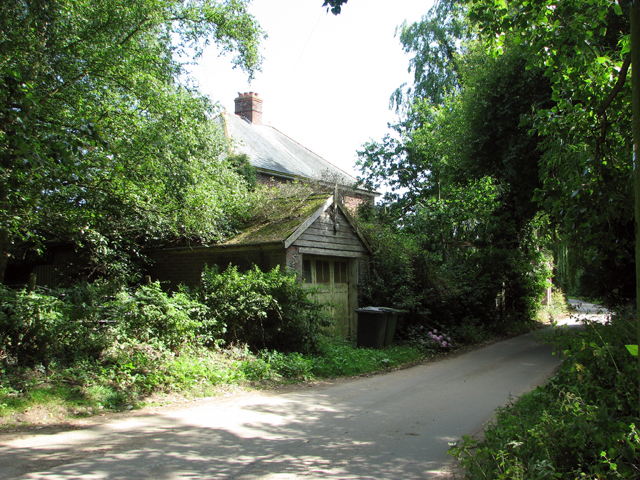
Two generations of the Goose family live in the other two houses and farm most of the surrounding land.
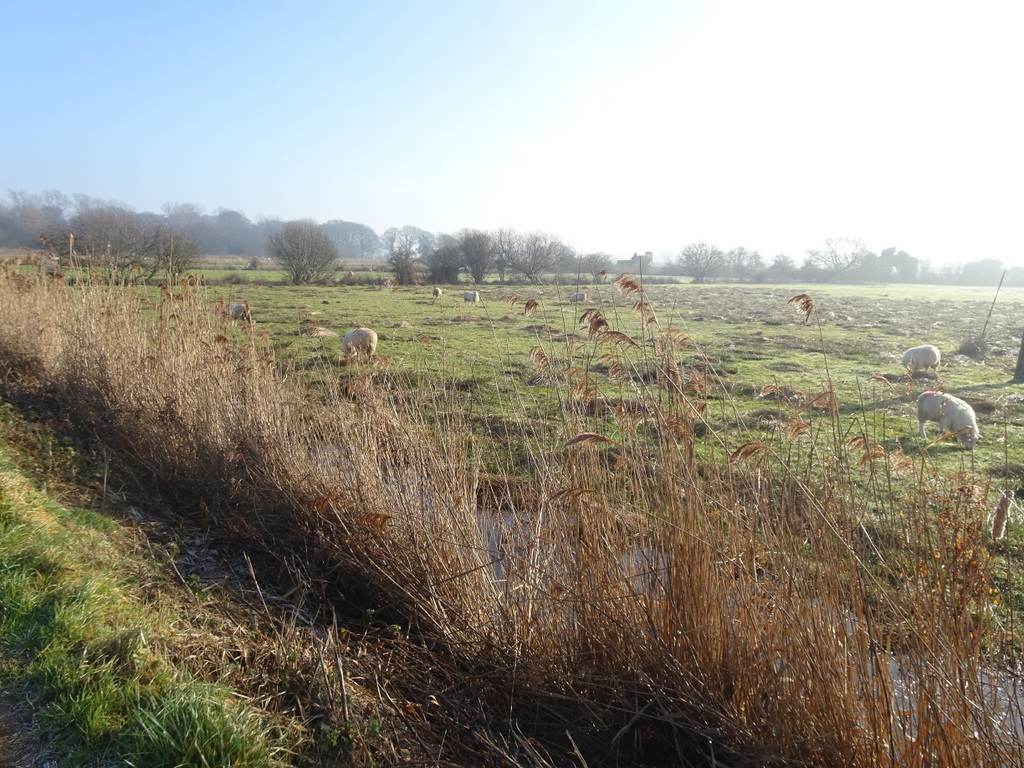
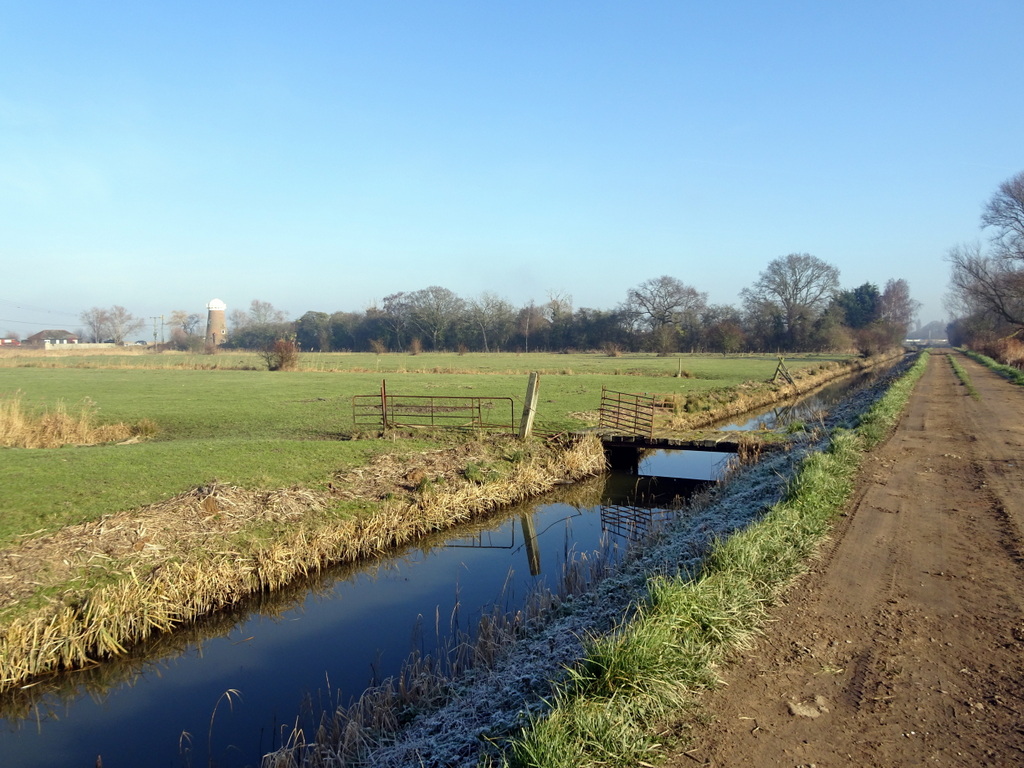
Most of the fields, marshes and meadows retain their same size and shape as they were at the time of the Inclosure in 1812 and the Tithe Award in 1842. Plot 622 is shown on the Tithe Map (above) as a long straight stripe and remains exacted the same, still cultivated by a member of the Turner family to this very day.
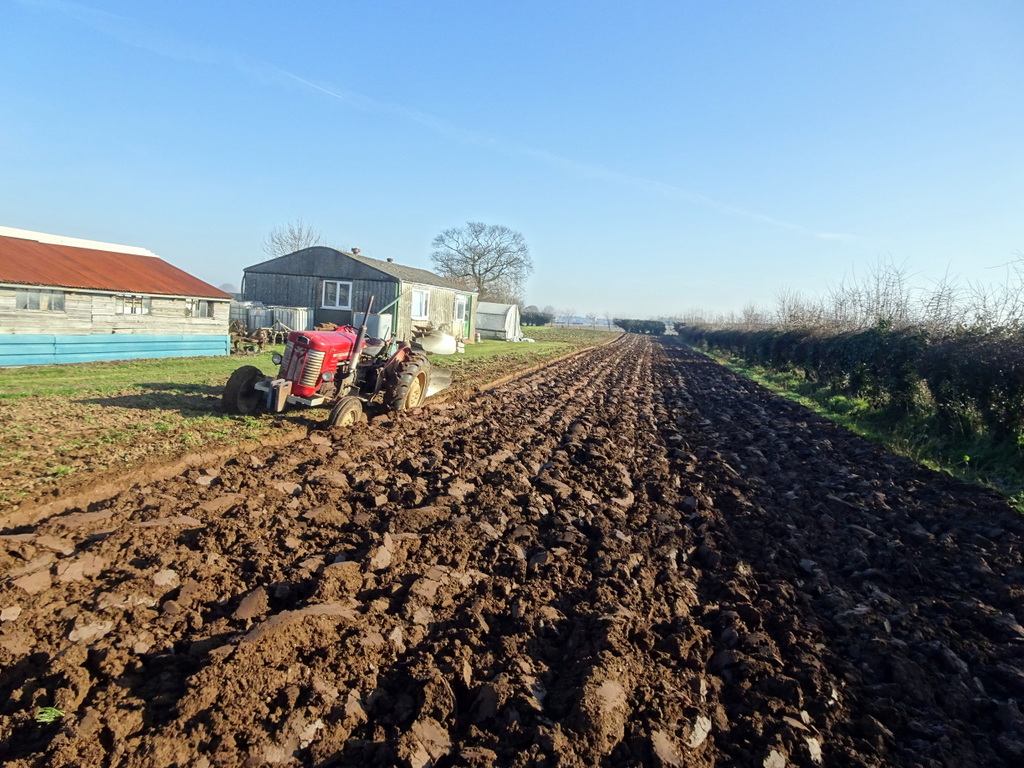
A surprising and wonderful new house has been built at Hyrn End on land once owned by Robert Watson (1706-1787) and then his son William (1742-1818). The multi level building echoes the shape of the former cottage and barns that once stood there. It is a passive house that appears to almost float in its surroundings and is a perfect compliment to the local environment.
This then is the story of Mustard Hyrn and many of the people who have lived there. The exercise may not have changed history but the discovery of a set of Wills from the Watson family has thrown light on how people lived in that part of Martham which would have been very similar to the rest of the village.
I would like to record my thanks to Ann Meakin, Paul Mathews and
Beverley Turner for their help with this topic.
Some passages were inspired by Robert Malster from his book ‘The Broads’.
(1) ‘Inventories of the Poor – Martham’ by Barbara Cornford.
Census information based on data provided by the Office for National Statistics (ONS).